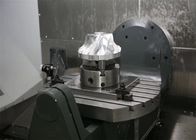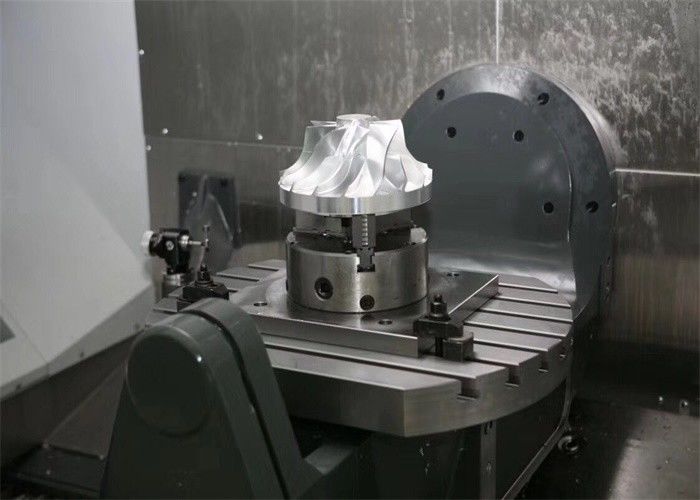Imported 14120 material use 3D printing rapid prototype exhibit mould product
Milling is the machining process of using rotary cutters to remove material from a workpiece by advancing (or feeding) the cutter into the workpiece at a certain direction. The cutter may also be held at an angle relative to the axis of the tool.Milling covers a wide variety of different operations and machines, on scales from small individual parts to large, heavy-duty gang milling operations. It is one of the most commonly used processes for machining custom parts to precise tolerances.
Milling can be done with a wide range of machine tools. The original class of machine tools for milling was the milling machine (often called a mill). After the advent of computer numerical control (CNC), milling machines evolved into machining centers: milling machines augmented by automatic tool changers, tool magazines or carousels, CNC capability, coolant systems, and enclosures. Milling centers are generally classified as vertical machining centers (VMCs) or horizontal machining centers (HMCs).
In manufacturing, computer numerical control (CNC) or simply numerical control (NC) is the automated control of machining tools (drills, boring tools, lathes) by means of a computer, in which a NC machine operates on a piece of material (metal, plastic, wood, ceramic, or composite) to transform it to precise specifications. NC machines combine a motorized maneuverable tool and often a motorized maneuverable platform, which are both controlled by a computer core, according to specific input instructions. Instructions are delivered to an NC machine in the form of graphical computer-aided design (CAD) files, which are transformed into a sequential program of machine control instructions, and then executed.
Product Description
1. Industrial grade 3D speed molding
2. Top precision equipment support, mature application in the development of the market for low-cost manufacturing, time consuming
| Product |
Imported 14120 material use 3D printing rapid prototype exhibit mould product |
| Place of Origin |
Dongguan,China |
| Product Scope |
Sculpture of Art,Animation model,Presentation model, Industrial design,Mould,Prototype hand - board,Building sand,Medical Biology,Automobile manufacturing,Figure etc. |
| Applied Materials |
Imported photosensitive resin |
| Surface processing |
Powder Coating, E-coat, Sand Blasting, Plating, Polish, Screen Printing |
| Machining Process |
Laser rapid prototyping (SLA, SLS)
1.Digital modeling
2.Adjustment model
3.3D Print finished product
|
| Type |
SLA, SLS |
| Price |
Manufactury Price |
| Sample |
Available |
| Thickness |
Customized according to your requirements |
| File Format |
Solidworks, Pro/Engineer, Auto CAD,PDF,JPG |
| Delivery Time |
Generally 7 Workdays or According to Quantity |
| Attention |
we will offer with best price, good quality, and first-class service |
As with CNC subtractive methods, the computer-aided-design – computer-aided manufacturing CAD -CAM workflow in the traditional Rapid Prototyping process starts with the creation of geometric data, either as a 3D solid using a CAD workstation, or 2D slices using a scanning device. For Rapid prototyping this data must represent a valid geometric model; namely, one whose boundary surfaces enclose a finite volume, contain no holes exposing the interior, and do not fold back on themselves.
In other words, the object must have an "inside". The model is valid if for each point in 3D space the computer can determine uniquely whether that point lies inside, on, or outside the boundary surface of the model. CAD post-processors will approximate the application vendors' internal CAD geometric forms (e.g., B-splines) with a simplified mathematical form, which in turn is expressed in a specified data format which is a common feature in additive manufacturing: STL (stereolithography) a de facto standard for transferring solid geometric models to SFF machines. To obtain the necessary motion control trajectories to drive the actual SFF, rapid prototyping, 3D printing or additive manufacturing mechanism, the prepared geometric model is typically sliced into layers, and the slices are scanned into lines (producing a "2D drawing" used to generate trajectory as in CNC's toolpath), mimicking in reverse the layer-to-layer physical building process.
 Your message must be between 20-3,000 characters!
Your message must be between 20-3,000 characters! Please check your E-mail!
Please check your E-mail!  Your message must be between 20-3,000 characters!
Your message must be between 20-3,000 characters! Please check your E-mail!
Please check your E-mail!

